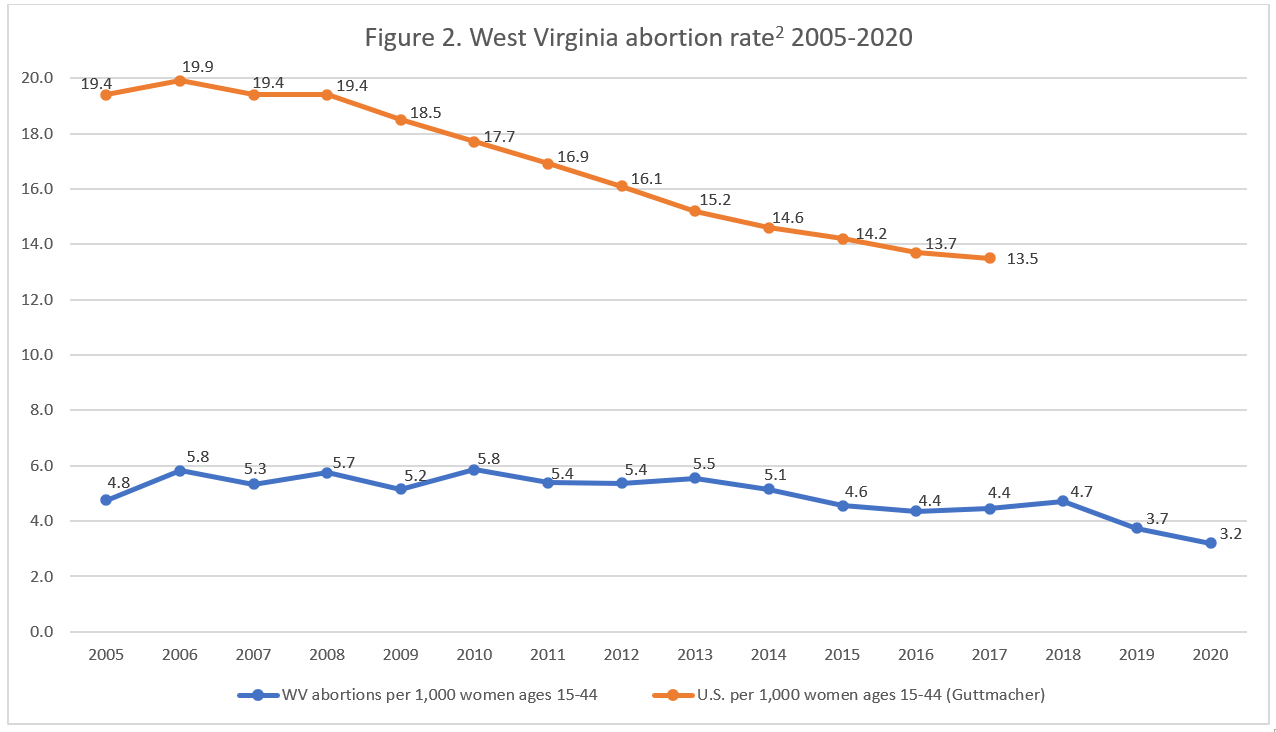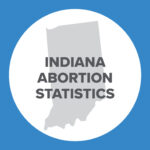Abortion Reporting: West Virginia (2020)
West Virginia’s 2020 abortion statistics were published in December 2021, showing that abortions in the Mountain State have declined sharply over the past two reports.
Changes in West Virginia Abortions, 2018-2019

The report does not include information on Planned Parenthood’s West Virginia abortion market share, but Planned Parenthood operates no abortion centers in West Virginia.
Abortion Totals and Trends
In 2020, there were 1,001 abortions reported in West Virginia, a drop of 15 percent from the previous year (Fig. 1). This followed a drop of 22 percent between 2018 and 2019. Chemical abortions increased by five percent from 489 in 2019 to 514 in 2020, making up 51 percent of the total in 2020. The Charlotte Lozier Institute (CLI) estimates that West Virginia’s abortion rate in 2020 was 3.2 abortions per 1,000 women ages 15 to 44, down 15 percent from 2019 and far below the national rate (Fig. 2). As of February 2022, 27 states had released 2020 abortion statistics, of which just eight reported that abortions had declined from the previous year.
State Report Summary
West Virginia’s State Report
West Virginia’s last full abortion report is for 2015, but the state has published separate reports with 2019 and 2020 data collected as required by its Pain-Capable Unborn Child Protection Act. The Act limits abortion at 22 weeks of gestation, unless the abortion is necessary to save a woman’s life or major bodily function, or the unborn baby has a medical condition that would prevent him or her from surviving outside the womb.
Fifty-nine percent of the abortions reported in West Virginia in 2020 were performed at eight weeks of gestation or earlier. Twenty-one percent occurred between nine and 10 weeks, and nine percent were performed between 11 and 12 weeks of gestation. Eight percent were performed between 13 and 15 weeks, and two percent were performed between 16 and 19 weeks. There were three abortions at 20 weeks of gestation or later; the report does not indicate whether any of these were performed after 22 weeks. In 2019, seven abortions were performed at or after 20 weeks of gestation, for a total of 10 abortions after 20 weeks between 2019 and 2020.
All three of the post-20-week abortions reported in 2020 were performed because the unborn babies were “non-medically viable.” The unborn babies’ conditions included holoprosencephaly, hydrops, and severe growth restriction. Two of the abortions were performed using a method that gave the baby the best chance of survival, while in one case the method of abortion was not chosen to give the baby the greatest chance of survival. Similarly, the seven late-term abortions reported in 2019 were performed because of poor prenatal diagnoses, including anencephaly, fetal acrania, and renal agenesis. One pregnancy was complicated by preterm premature rupture of the membranes, and one was a partial molar pregnancy.
In 2020, 51 percent of West Virginia abortions were chemical abortions, while 48 percent were performed using dilation and curettage. There were nine dilation and evacuation procedures (not quite one percent).
West Virginia publishes information on its informed consent process in a separate report. In its 2019 report, West Virginia indicated that informed consent counseling was provided in advance of all but three abortions. Five abortions were performed due to medical emergencies; the report does not state whether these included the three abortions for which counseling was not provided. The 2020 informed consent report has not yet been published.
Centers for Disease Control and Prevention
West Virginia’s 2019 and 2020 reports contain no information on the age, race, marital status, or pregnancy history of women who obtained abortions in the state. However, West Virginia shares demographic information with the Centers for Disease Control and Prevention (CDC) to be included in annual abortion surveillance reports. The most recent CDC abortion surveillance report is for 2019.
West Virginia reported to the CDC that 1,183 abortions were performed in the state in 2019, of which 86 percent were performed on West Virginia residents and 14 percent were performed on nonresidents, primarily on women from Kentucky and Ohio. Additionally, another 526 abortions were reported to have been performed on West Virginia residents in other states, although not all states (including nearby Maryland) report this information. Demographic information is not included for the 526 out-of-state abortions.
Ten percent of West Virginia abortions were performed on girls ages 19 and younger in 2019, including eight abortions performed on girls under the age of 15. Thirty-two percent of the abortions were performed on women ages 20 to 24, and 27 percent were on women ages 25 to 29. Twenty-eight percent were obtained by women in their thirties, and three percent were performed on women who were age 40 or older.
The CDC surveillance report shows that 83 percent of West Virginia abortions were performed on non-Hispanic white women, while 13 percent were performed on non-Hispanic black women. The remaining four percent were performed on Hispanic women and on non-Hispanic women of other races. CLI estimates that the non-Hispanic black abortion rate, 11.2 abortions per 1,000 women ages 15 to 44, was more than three times the non-Hispanic white rate (3.4).
Thirty-six percent of the abortions reported in West Virginia were performed on women who had no previous live births. Twenty-nine percent were on women with one prior live birth, and 35 percent were on women with two or more previous births. Sixty-two percent of the abortions were obtained by women with no prior abortions, 25 percent were on women with one previous abortion, and 13 percent were on women with more than one prior abortion. Eighty-three percent of the abortions were performed on unmarried women, and 17 percent were performed on married women.
Taxpayer-Funded Abortion in West Virginia
Between 1993 and 2018, West Virginia was required by a court ruling to fund “medically necessary” abortions for women enrolled in Medicaid. In practice, almost all abortions qualified as “medically necessary.” In 2018, West Virginia voters ratified a constitutional amendment to clarify that “Nothing in this Constitution secures or protects a right to abortion or requires funding of abortion.” As a result, West Virginia now funds abortions only in cases of rape or incest, risk to the mother’s life or a major bodily function, or instances in which the unborn baby has a severe condition or is not expected to live outside the womb.
A report from the Bureau of Medical Services to the West Virginia legislature shows that before the constitutional amendment was enacted, state-funded abortions were increasing. In fiscal year 2009, which ran from July 1, 2008, through June 30, 2009, West Virginia funded 677 abortions. In fiscal year 2017, West Virginia funded 1,560 abortions at a cost to taxpayers of more than $326,000. Over the time period of July 2016 – June 2017, only an approximate 1,430 abortions were reported in West Virginia, suggesting that many state-funded abortions took place out of state. Some healthcare facilities within 30 miles of West Virginia qualify as “border providers” and accept West Virginia Medicaid the same way that in-state providers do. Multiple abortion centers are located within 30 miles of West Virginia, including a center that previously accepted West Virginia Medicaid. However, it is likely that many taxpayer-funded abortions also took place in-state, which may have contributed to the drop in abortions in 2019 and 2020 once West Virginia no longer paid for abortions.
State Ranking
In 2016, CLI analyzed abortion reporting across the 50 states, the District of Columbia, and New York City. West Virginia tied for 21st best. To improve its reporting, West Virginia could release its full report on a faster schedule. Additionally, West Virginia could collect and report data on complications caused by abortion, as many other states do.


- Total and chemical abortions for 2005-2015 were taken from CDC surveillance reports. Totals for 2016-2020 were taken from West Virginia’s 2020 abortion report.
- Rates were calculated by CLI using the following formula: (total number of abortions performed in West Virginia ÷ number of resident women ages 15-44) x 1,000. Rates may differ slightly from previous CLI articles due to revised population estimates. Population estimates were obtained from the CDC WONDER database.
Percentages may not add to 100% due to rounding.

























